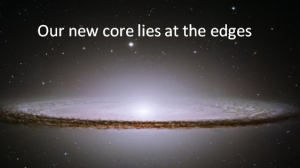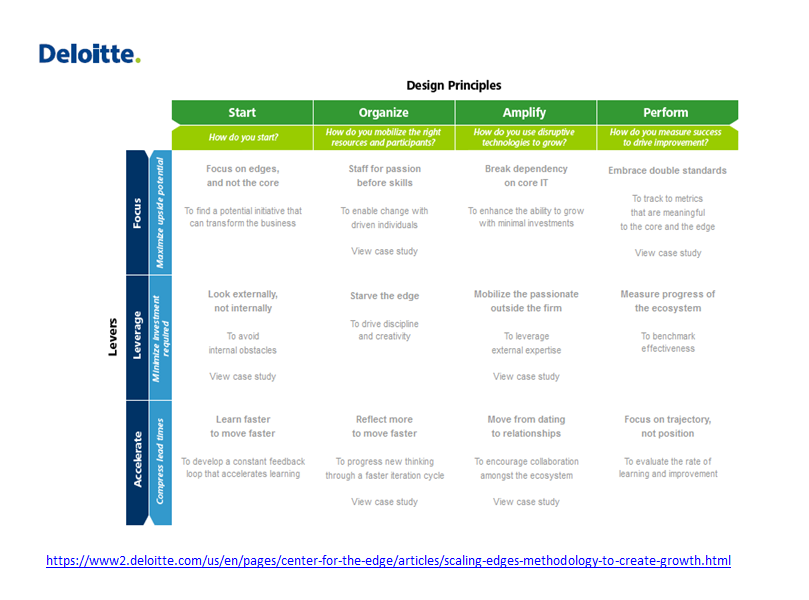 Boundaries seem to be continually pushed in business, nothing seemingly is standing still, yet we are faced with many things that stay caught up in simply not being changed. Something eventually has to change, there is increasing pressure. We need to jettison old ways and establish new ones. In with the new in 2017, out with the old.
Boundaries seem to be continually pushed in business, nothing seemingly is standing still, yet we are faced with many things that stay caught up in simply not being changed. Something eventually has to change, there is increasing pressure. We need to jettison old ways and establish new ones. In with the new in 2017, out with the old.
I continue to read and explore as much of the thought leadership on innovation, it continually points to a change in how we approach innovation.We need to embrace this need for change.
I have written about the new innovation era in 2017 made up of higher levels of needed collaboration, where platforms, ecosystems and customer experience understanding become increasingly central. We need to push well beyond our existing core of innovation understanding, we actually need a new innovation institutional design.
We are pushing further away from the old core.
The tenet of each organization in the past has been in protecting its core. This is changing as the very core is changing to adapt to more volatile conditions, changing landscapes and more disruption. The core is not so much in what we know or own but in what we can learn from that surrounds our core and this is increasingly found at the edges and externally.
Let me explain
The customer is critical, they are becoming central to any innovation, and they are our need to fully understand, to turn the fuzziness into opportunity. We need to start constantly at understanding the customer, their needs, their individual journey by discovering and engaging with them. We are rapidly appreciating the combination effect of technology, the data exchanges, and the analytics we gain from this. The combination effect is changing the starting point of innovation, it is not beginning in idea generation found inside the building, and it is discovery found outside brought in, to then turn into potentially commercial ideas. These can only be found at the edge, the customer edge.
The old concept of internally thinking of growth being reliant on internal product and service extension is failing to move this growth needle apart from limited short-term gains. We can’t rely on simply ‘tweaking’ the existing core anymore. We need to think differently
Scale, scope, and speed are becoming dominate in all we need to think through
To become more aggressive and combat the disruptive forces at work all around us we must go to the edge. The edge can be still made up of products, services, and market opportunities but we need to consider the underlying forces that are at work within this and these lie outside our own domain of physical building, experience or our existing techniques to exploit the known.
We need to find the unknown, we need to pick up on the weak signals we can only find at the edges and begin to build a very different institutional innovation set of capabilities.
The value of the three horizons comes into play here even more as an innovating force of change
Horizon 2 and especially horizon 3 are exploring the edges; they should be set up for discovery, for experimenting and learning.
Horizon thinking goes well beyond “just” internal thinking and building a portfolio, it needs to be extended into understanding its growing role in platform and ecosystem design.
As we think beyond the one entity we are moving from the existing products and service in horizon 1, to building a new platform constellation of connected products and services in horizon 2, and looking to form a network of ecosystems to explore these emerging edges in horizon 3. I will be exploring this connecting the three horizons into platform and ecosystem thinking further, at a later time.
Edges, if chosen well become eventually the new core – they give fresh perspective
We need to think about scalable learning, we need to quickly translate potential scope and deliver understanding at new speeds that our present core can’t cope with. The present core is designed for exploitation, for efficiencies and effectiveness and it relies on predictability.
The edge is the opposite; it needs constantly exploring, adjusting, learning and experimenting. Yet this cannot be left to ad hoc design, it needs this institutional design. It functions differently than the core, it requires the dual management practice often discussed around the solutions within the design of ambidextrous organizations. It ‘pulls in’ the understanding
I constantly find Deloitte’s thinking as leading edge. Often to absorb this thinking can take time and the appropriate conditions can come later. That is thinking at the edge so you draw in the understanding and this becomes more central to your own core. Deloitte’s often have this impact on me.
They have written about innovating at the edge for some time. They argue an edge opportunity has four distinct characteristics that differentiate.
In the short-term– an edge requires minimal investment to initiate and the edge has to have the potential to grow the pie.
In the longer-term – an edge aligns with the long-term disruptive shifts in the market and has the potential to transform the core.
The design principles of the Edge offered by Deloitte as a framework.
GE, for example, is taking Predix from the cloud to the edge.
Predix is the GE operating system for the Industrial Internet, has been opened up as a platform for outside companies to write apps, have access to collect and harvest data, as well as have access and use of all the tools available for the data collected in the cloud to be analyzed on this Predix platform. GE recently recognized and decided to place machine apps anywhere, literally at the edge of any networks or systems on devices, on controllers, in positioning this analysis capability as a network gateway or router, ultimately connecting back to the cloud.
This change in thinking actually takes innovation to the edge, it delivers knowledge to the customer who has invested in the machine. It changes the relationships, alters the dynamics of managing. Can this thinking of data, platforms, ecosystems and relationships with the actual (human) customer be equally managed at the edge, I think so.
This can give ‘edge understanding’ by each device, by each interaction, by what needs to be completed. The application of thinking at the edge is where you can gain insights faster. Where you can run programs faster, adapt them to local environments and exchanges, develop dialogues by running a quick analysis on or close to the machine or the person using the machine themselves.
As GE claim in their case “the edge is the place where the cloud meets the customer environment”. You can then get a better prediction on the spot, you can make needed personal corrections and over time the machine has the capability to learn over time what is optimal, what is needed to be completed, what will help optimize the process.
So the edge can begin to transform the core
Thinking at the edge can be very transforming, can you imagine the Smart Phone, or other smart devices being the edge, where the exchange takes place, the knowledge collected and shared and the relationship forms to design the innovation future, as close as you can get, in the consumer’s hands. It is a reality already, we just have to reconceive this differently.
Edges require different practices from the core; they, over-time impact the core, hence why we need to begin to think through institutional innovation change to accommodate this leading from the edge.
The value of considering platforms and ecosystems within this redesign allows you to accelerate outside learning, leverage the knowledge available across a broader community and can deliver internally new understanding and knowledge in areas where the core lacks or is inadequately set up in expertise. It contains the core of the existing business; it allows you to tap into opportunities of tomorrow in new shared ways. It defrays the cost, it limits risk, it gains ways to quickly learn and connect with different areas of specialization not found within the one organization.
Today it is not “stocks of knowledge” as these rapidly lose value, it is the “flows of knowledge” and these come increasingly within the relationships you form at the edges and platforms and ecosystems can accelerate these flows and leverage knowledge and discovery.
We do need to reconceive innovation- our new core is found at the edges if growth is important to you. It is how you apply all that is potentially available to you today, to leverage and learn what is valued and needed.

2 thoughts on “The future innovation core lies at the edge.”
Comments are closed.